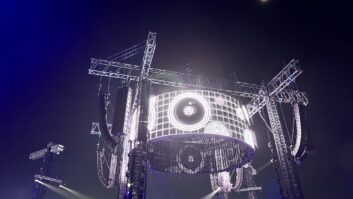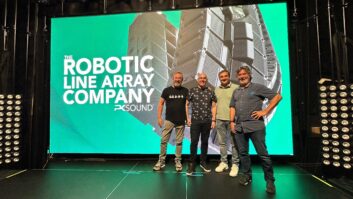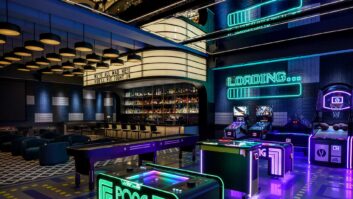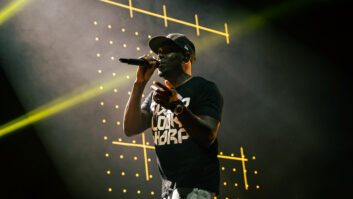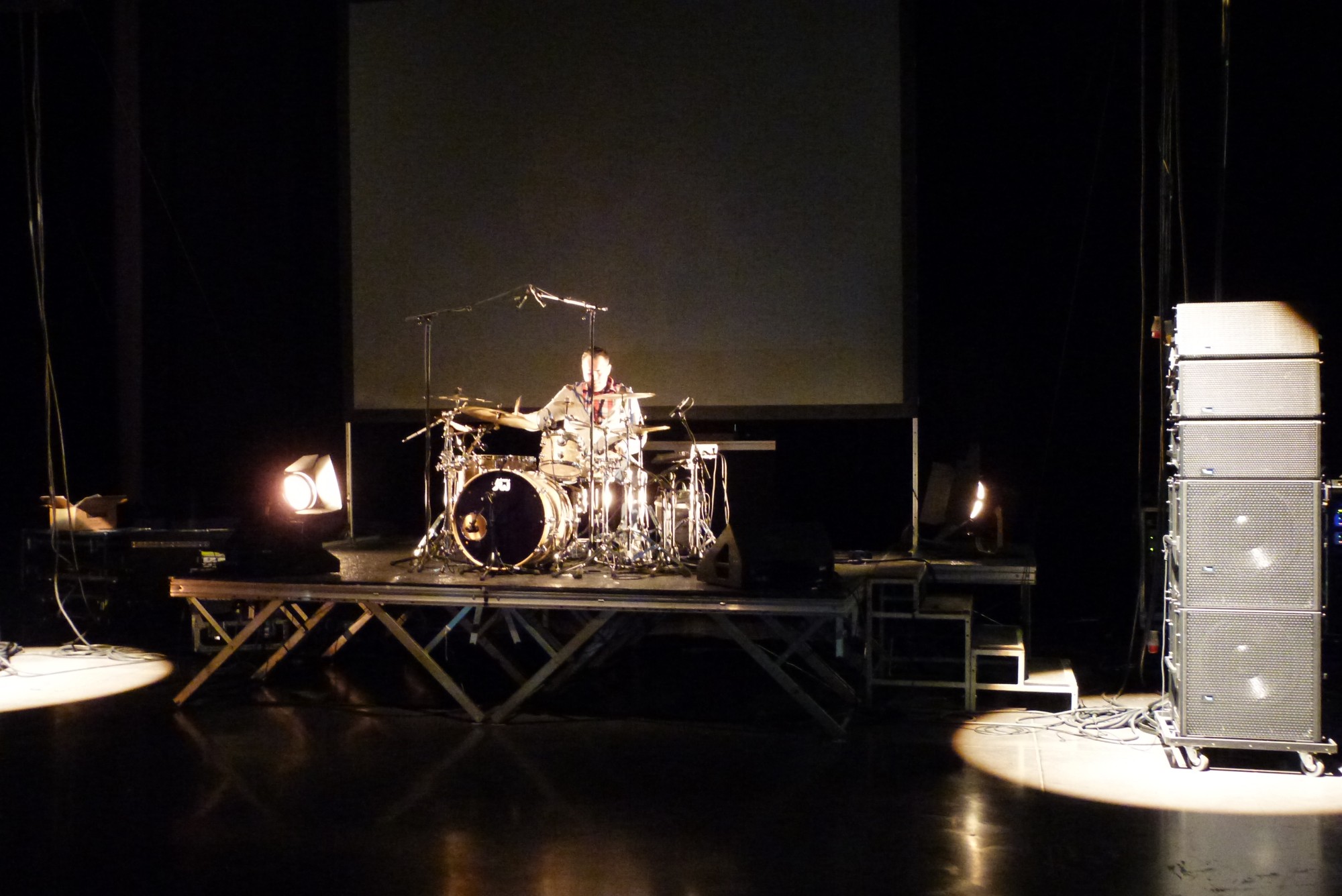
Following their unveiling at Prolight + Sound in April, Meyer Sound’s Leopard and 900-LFC system is now touring Europe. Franck Ernould went to Dushow’s Le Studio, near Paris, for the Leopard’s very first public listening session.
Meyer Sound distributor Dushow’s Le Studio is, in essence, a ‘private’ concert hall: at 10m high and with a floor area of 900sqm plus a 100sqm mezzanine it is used to prepare Dushow systems before going on tour, or for ‘real-size’ demos – like this one.
Different, but similar
The Meyer Sound Leopard active speaker hosts two 9in long-excursion LF drivers and one 3in compression driver, coupled to a CD horn through a patented REM manifold – thus combining the benefits of compression drivers and ribbon drivers. Each speaker is 69cm long, 28cm high and 56cm deep, weighs 34kg, and hosts three channels of open-loop Class D amplification. It is complemented, for low-end enhancement, by the 900-LFC, which is a 64cm cube that weighs 61kg and has an operating range from 31Hz to 125Hz. For comparison, a LEO speaker weighs 116kg, a Lyon 90kg, and an 1100-LFC 113kg.
“With Leopard, we wanted to make the UPA [one of the manufacturer’s first sound-reinforcement speakers] of line arrays,” says Luke Jenks, Meyer Sound’s director of product management. “When a company buys UPAs, financial people love them because the speakers are always out and no one complains about them. Renting, touring or installing them, everyone is happy. The techs like them too: they plug in, it goes, they’re simple to use and sound great. Same thing with the Leopards: LEO and Lyon are both pretty prodigious large systems, but not everyone in the world needs a system so strong. Twelve of them can be hung on a single half-ton point, or six Leopards plus two 900-LFC.
“Every element is brand new in the Leopard system: drivers and Class D amplifiers, we get 10 times less distortion with them. But Leopard’s common point with LEO and Lyon is that they all share the same sort of drivers. They have the same tonal signature, so they’re extremely easy to blend with each other. The rigging is the same type, the transitions are well thought of, very seamless, and all of these horns have been designed with each other in mind. ”
Jenks has much to say about the 900-LFC too: “When we came out with the 1100, we didn’t call it a ‘subwoofer’, we called it ‘LFC’, for low-frequency component. Lots of people said to us, ‘Why won’t you call it a subwoofer, like the others?’ Well, it’s a speaker that makes low frequencies, it was difficult to design, and if people had worked so long and hard on a product, like our company has, they wouldn’t call it a subwoofer either. Now people understand that the 1100 is something different. It is very successful, but customers wanted the same thing in a smaller package. The 900-LFC is very similar to the 1100, but it can be controlled a little higher up in frequency, with a slightly extended upper range. The quality is the same: no one would accept the 900 just because it’s smaller then the 1100, without having optimum performance. It was a big challenge for our designers, but once again, Pablo Espinosa and his team in the R&D department did a great job.”
Unobtrusive but powerful
The idea behind these Leopard demo sessions is to hear the system per se. In Le Studio, there were three speakers and two subs on the ground per side, plus six speakers and four subs hung. At the beginning of the listening session, the system was used with CDs or DVDs, with the six speakers hung and one then two subs on the ground. Then the user was free to ask what he wanted, and to listen to whatever CDs he requested or had brought with him.
“People are very much impressed by the capabilities of the system, how musically it sounds, how powerful it is, with so much headroom. One box is 34kg, so you have an excellent power-to-weight ratio. Our customers have major issues regarding size and weight. There are many halls throughout Europe where you only have half-ton flying points to hang the systems, so they must be lightweight. And a lot of our customers do not only do touring, but also corporate events, trade shows, company AV events. Their clients do not like speakers that you can see. They like them high up in the air, as invisible as possible, but with high SPL and precision. With the Leopards, it’s easier to get these results.”
Near the Galileo rack, a sign reads: ‘Without any treatment or EQ’. The choice to hear the system ‘naked’ seems audacious. But as Jenks says: “We prefer, during our private demo sessions, to listen to the system in ‘native’ mode: no processing, no EQ. Users can hear it ‘naked’, and they are intelligent, they’ll listen to it and decide how to apply that. France has the highest level of Meyer Sound membership, I mean people who have signed up for our production programme; I think there is the highest level of system engineering in the world. Here, people pay most attention to design a system properly, then to fine-tune. There are more people in France who understand what a transfer function is than anywhere. There’s a lot of very high-level people in the world, but I would say the ‘standard’ level is the highest in France.
“We try to make people’s lives easier. We pay much attention to speakers, amplifiers… But over the years, our competitors did a better job of making packages of their things, and after a while, people started to regard self-powered systems as more complicated, which is a tragedy! We have to step back, and to make sure that prediction software, cabling, AC distribution, all of these things are simple. That’s why we now have a distribution module (MDM-5000) for audio and AC, for rental use and standardisation. Self-powered must be easy to use. We paid a lot of attention to that too.”
Drums colour
The listening session itself was very interesting. It began with six hung speakers per side and one 900-LFC on the ground. The Eagles unplugged, Diana Krall, Dee Dee Bridgewater, you name it: the sound was very precise, focused and well distributed. Beethoven’s Ninth Symphony sounded as played by a real orchestra, not synthesisers or samplers. Then, with a second 900-LFC added by the side, things went pretty loud on bass-driven music. Peter Schädel, Meyer Sound marketing manager Germany, told us he had measured 110dB SPL on average in the dressing rooms in the mezzanine, far away from the stage, during the day, when trying the system. And actually, with eyes closed, the sound was much bigger than the speakers themselves. Pretty impressive…
Another experiment was worth listening to: instead of a complete band, there was only a drummer on stage, who began playing without any sound reinforcement. Then the faders of the DiGiCo SD mixing console were raised slowly, and it was obvious that the sound of the drums didn’t change. Level kept rising, reaching high SPL, and the sound colour still didn’t change. That says something about the design of the system.
“Leopard speakers can, of course, be used in fixed installations, and we think this market will be huge,” says Jenks. “We will be holding demos like this one in Europe, USA, Asia, Latin America… A major factor of interest for installation will be the speakers, size, of course, but their high quality too, thanks to the low distortion.”
Interest is clearly high in the Leopard and the first orders have already been placed: Bright Norway AS ordered 60 Leopards plus 18 900-LFC and Sonalyst Place (UK) opted for 96 Leopard and 24 900-LFC. Production will begin in June.


